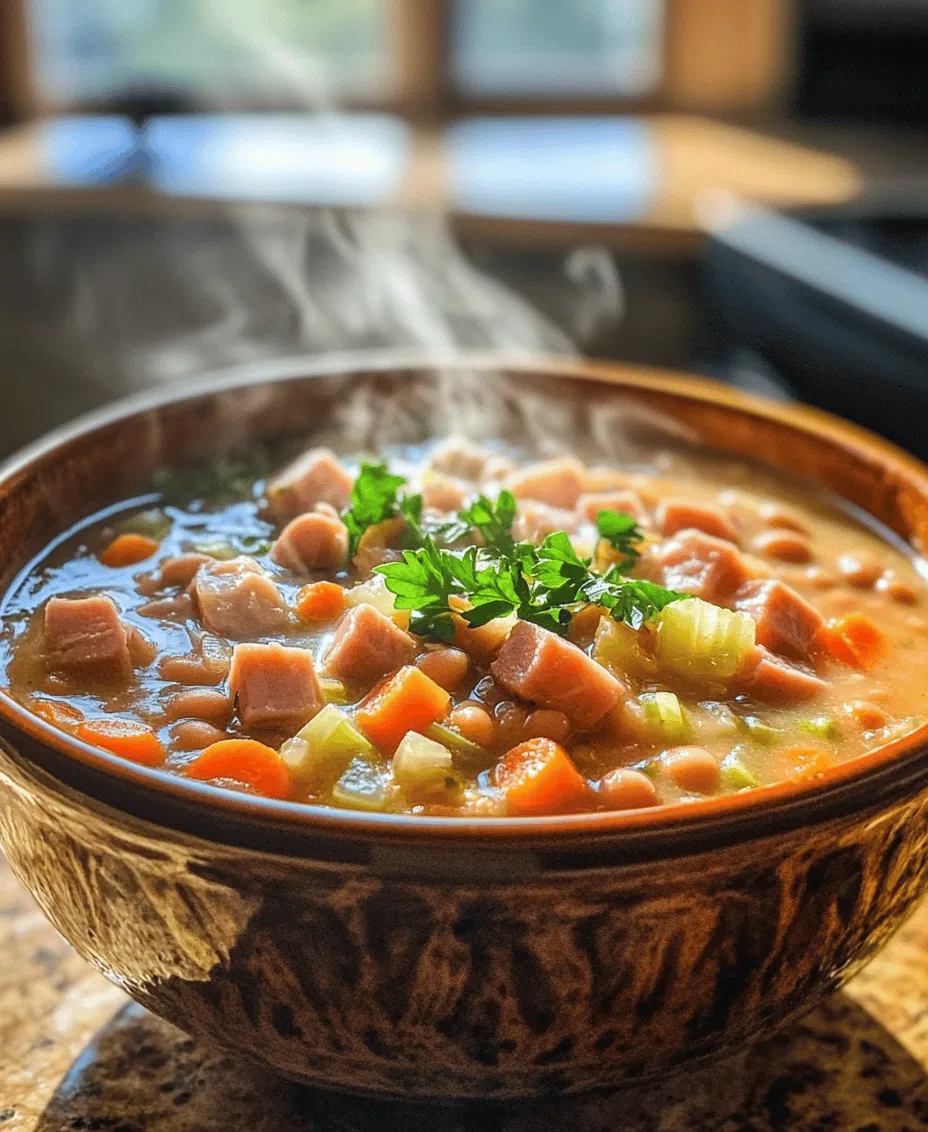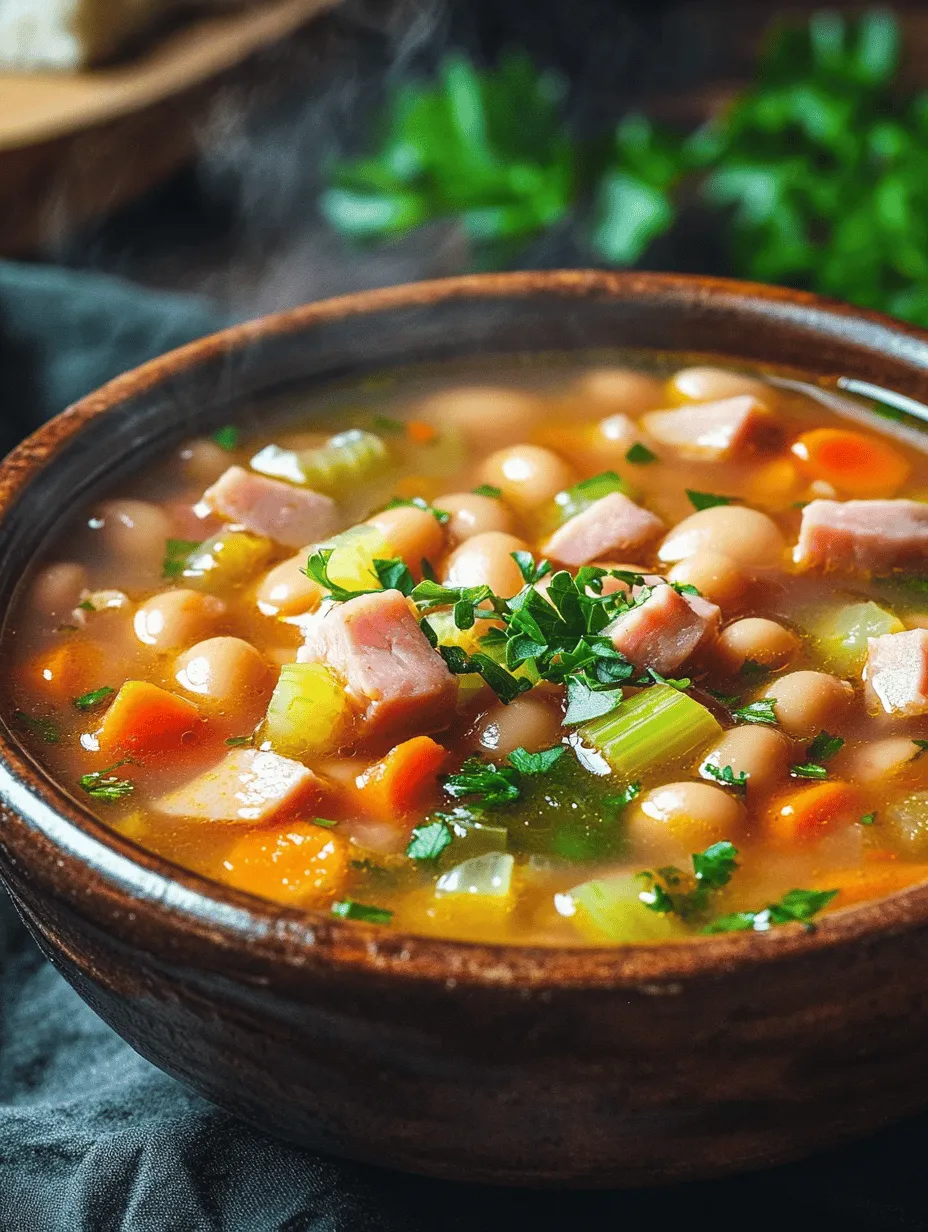Introduction
Homemade soups are the epitome of comfort food, providing a warm embrace on chilly days and a nourishing option for any meal. Among the myriad of soup varieties, few can rival the heartiness and satisfaction of a well-crafted ham and bean soup. This dish not only warms the soul but also offers a delightful combination of flavors and textures, making it a go-to recipe for families and gatherings alike.
The nutritional benefits of ham and beans are impressive. Ham, a rich source of protein, adds depth to the dish, while beans contribute dietary fiber, essential for digestive health. Together, they create a balanced meal that can be enjoyed year-round, making this hearty ham and bean soup a versatile choice for both cozy winter nights and casual summer picnics.
In this article, we will delve into the details of crafting a delicious hearty ham and bean soup, exploring its ingredients, preparation steps, and cooking techniques. Whether you’re looking for a dish to serve on a cold evening or a nutritious option to feed a crowd, this recipe is sure to impress.
Understanding the Ingredients
To create a truly unforgettable ham and bean soup, it’s essential to understand the role each ingredient plays in crafting the perfect bowl. By opting for quality ingredients, you can elevate the dish’s flavor profile and nutritional value, ensuring that every spoonful is satisfying.
Diced Cooked Ham
At the heart of this recipe lies diced cooked ham, which serves as both a protein source and a flavor enhancer. The richness of the ham infuses the broth with a savory depth, making each bite a delight. When choosing your ham, consider selecting one that is smoked or honey-glazed for added complexity in flavor.
Dried Navy Beans
Dried navy beans are the star of the show, known for their creamy texture and subtle flavor. These small white beans are high in fiber and protein while being low in fat, making them a wholesome addition to any diet. Soaking the beans before cooking not only helps to soften them but also aids in digestion by reducing certain oligosaccharides that can cause discomfort.
Chicken Broth
The choice of broth can significantly impact the overall taste of your soup. Chicken broth adds depth and richness, creating a comforting base that complements the other ingredients. For an even more flavorful soup, consider using homemade chicken broth or a high-quality store-bought option that is low in sodium. This allows you to control the saltiness of the final dish.
Vegetables
A medley of vegetables—including carrots, celery, onion, and garlic—provides essential vitamins and minerals while enhancing the soup’s flavor. Carrots add a touch of sweetness, celery brings a subtle earthiness, and onions and garlic contribute aromatic qualities that are fundamental to the dish. Sautéing these vegetables at the beginning of the cooking process helps to develop their flavors, creating a robust base for the soup.
Herbs and Spices
No soup is complete without the addition of herbs and spices, which elevate the dish’s aromatic qualities. In this recipe, thyme, smoked paprika, and bay leaf work together to create a well-rounded flavor profile. Thyme adds a hint of earthiness, while smoked paprika introduces a subtle smokiness that pairs beautifully with the ham. The bay leaf infuses the broth with a gentle herbal note, enhancing the overall complexity of the soup.
Preparation Steps
Crafting a hearty ham and bean soup involves several straightforward yet essential preparation steps. Each step contributes to the final flavor and texture of the dish, ensuring a satisfying and delicious outcome.
Sautéing the Vegetables
The first step in preparing your soup is to sauté the vegetables. Start by heating a generous amount of olive oil in a large pot over medium heat. Once the oil is shimmering, add chopped onions, carrots, and celery. Sauté these vegetables for about 5-7 minutes, stirring occasionally, until they become tender and the onions are translucent.
To avoid burning, it’s important to monitor the heat closely and stir regularly. If the vegetables begin to brown too quickly, reduce the heat slightly. This technique not only softens the vegetables but also caramelizes their natural sugars, enhancing their flavors and providing a rich foundation for your soup.
Incorporating the Ham and Spices
Once the vegetables are perfectly sautéed, it’s time to incorporate the diced cooked ham and the spices. Add the ham to the pot and stir it in with the sautéed vegetables, allowing it to heat through for about 2-3 minutes. This step helps the ham to release its savory flavor into the mixture.
Next, sprinkle in your chosen spices: thyme, smoked paprika, and a bay leaf. Stir to combine, ensuring the spices coat the ham and vegetables evenly. The aroma will be irresistible, filling your kitchen with a warm and inviting scent.
Combining Beans and Broth
After the ham and spices have been incorporated, it’s time to combine the dried navy beans and broth. If you soaked your beans overnight, drain them and rinse them before adding them to the pot. This step is crucial as it helps to remove any impurities and ensures the beans cook evenly.
Pour in enough chicken broth to cover the beans and vegetables by about an inch. This quantity will vary based on your desired soup consistency; for a thicker soup, use less broth. Bring the mixture to a boil over high heat, then reduce the heat to low, allowing it to simmer gently.
Simmering for the Right Consistency
Simmering is where the magic happens. Allow the soup to simmer for approximately 1 to 1.5 hours, stirring occasionally, until the navy beans are tender. The cooking time may vary based on how long you soaked the beans and their freshness.
If you prefer a thicker consistency, you can use a potato masher to gently mash some of the beans against the side of the pot to release their starches. This will create a creamy texture without the need for additional thickeners.
Cooking Techniques
To ensure your hearty ham and bean soup turns out perfectly, there are several cooking techniques to keep in mind. These tips will help you achieve the best results while avoiding common pitfalls.
– Sautéing Vegetables Effectively: Always heat your pot before adding oil and vegetables. This prevents sticking and promotes even cooking. Be sure to keep the vegetables moving in the pan to avoid burning or uneven browning.
– Controlling Simmering: Once you’ve reached a boil, reduce the heat and maintain a gentle simmer. Rapid boiling can cause the beans to break apart and result in a less appealing texture.
– Adjusting Seasoning: Taste the soup periodically as it cooks. You can adjust the seasoning by adding salt, pepper, or additional herbs as needed. Remember that flavors develop as the soup simmers, so don’t rush to season it at the beginning.
With these preparation steps and cooking techniques, you’re well on your way to creating a delicious and satisfying bowl of hearty ham and bean soup. Stay tuned for the next part of this article, where we will explore additional tips for perfecting your soup and answer some common questions about this beloved recipe.

Simmering vs. Boiling: The Key to Flavor Development
When making a hearty ham and bean soup, understanding the difference between simmering and boiling is crucial for achieving the best flavor. Boiling occurs at a higher temperature (around 212°F or 100°C), leading to rapid bubbles and movement in the pot. While this method can cook ingredients quickly, it often results in a less nuanced flavor and can cause delicate components to break down too much.
Simmering, on the other hand, is a gentler cooking method, typically maintained at a temperature between 180°F to 205°F (82°C to 96°C). This allows the flavors to meld harmoniously without the aggressive agitation that boiling brings. The soup’s ingredients release their flavors gradually, creating a rich, cohesive broth that highlights the smoky essence of the ham and the earthiness of the beans. For the best results, bring your soup to a boil to kickstart the cooking process, then reduce the heat to a simmer and cover the pot.
Adjusting cooking times based on your preferred bean texture is also essential. If you enjoy your beans tender but not mushy, consider simmering the soup for a shorter duration—around 30 to 45 minutes after the initial boil. For softer beans that blend seamlessly into the broth, a longer simmering time of 1 to 2 hours may be more suitable. Tasting the soup periodically will help you achieve your desired bean texture.
Flavor Enhancements
One of the joys of cooking is the ability to customize recipes to suit your taste preferences. Here are some variations to consider when making your hearty ham and bean soup:
– Alternative Beans: While traditional recipes often call for navy beans or great northern beans, experimenting with different types can yield delightful results. Cannellini beans, for example, have a creamier texture and a slightly nuttier flavor profile. Black beans can add a unique twist, bringing a deeper color and rich earthiness to the dish.
– Spices and Herbs: Don’t shy away from adding additional spices or herbs to elevate your soup. A pinch of smoked paprika can enhance the smoky notes of the ham, while a dash of cayenne pepper can introduce a pleasant warmth. Fresh or dried herbs like thyme, rosemary, or bay leaves can infuse the soup with aromatic qualities that complement the other ingredients.
– Vegetable Additions: Incorporating vegetables such as spinach or kale not only boosts the nutritional content of your soup but also adds a splash of color. These leafy greens can be added during the last 5 to 10 minutes of cooking to ensure they retain their vibrant hue and nutrients. Carrots, celery, or bell peppers can also be sautéed with the onions for a more robust flavor base.
Serving Suggestions
Presentation can transform a simple bowl of soup into an inviting meal. Here are some ideas for serving your hearty ham and bean soup:
– Garnishes: Fresh parsley is a classic garnish that brings brightness to the dish. Not only does it enhance the visual appeal, but it also adds a fresh flavor that balances the richness of the soup. Consider finely chopping the parsley and sprinkling it over each bowl just before serving.
– Complementary Side Dishes: Pairing your soup with the right sides can create a satisfying dining experience. Homemade cornbread or crusty bread is an excellent choice for soaking up the flavorful broth. A simple mixed green salad dressed with a light vinaigrette can also provide a refreshing contrast to the hearty soup.
– Presentation Tips: To create a visually appealing meal, serve the soup in rustic bowls that highlight its hearty nature. You may also want to drizzle a bit of olive oil on top for added richness and an attractive sheen. For a touch of elegance, consider serving the soup alongside a small cheese platter featuring mild cheeses that complement the soup’s flavors.
Nutritional Information
Understanding the nutritional value of your meal is essential for maintaining a balanced diet. Here’s a breakdown of the nutritional content per serving of ham and bean soup:
– Calories: Approximately 300-400 calories per serving, depending on the amount of ham and beans used.
– Protein: Ham and beans are excellent sources of protein, providing about 20-25 grams per serving.
– Fiber: Beans are high in fiber, offering around 10-15 grams, which is beneficial for digestive health.
– Vitamins and Minerals: The soup is rich in essential vitamins and minerals, including iron, potassium, and magnesium.
Incorporating ham and beans into your diet can be beneficial, as they provide a good balance of protein and fiber. Additionally, they are relatively low in fat, especially if you choose lean cuts of ham. When considering portion control, a serving size of about 1.5 to 2 cups is generally satisfying, especially when served with sides.
Storage and Reheating Tips
To enjoy your ham and bean soup beyond the initial serving, it’s important to follow best practices for storage:
– Storing Leftovers: Allow the soup to cool to room temperature before transferring it to an airtight container. It can be stored in the refrigerator for up to 3-4 days. If you want to keep it longer, consider freezing it in portions for up to 3 months.
– Reheating: When reheating the soup, it’s best to do so slowly. Place the desired portion in a saucepan over medium heat and stir occasionally until heated through. You may need to add a splash of broth or water to maintain the desired consistency. Avoid reheating in the microwave unless necessary, as it may lead to uneven heating.
– Shelf Life: In the refrigerator, the soup can maintain its quality for several days. Freezing may alter the texture slightly, but the flavors will remain intact. Always label containers with dates to keep track of freshness.
Conclusion
Hearty ham and bean soup is not just a meal; it embodies warmth and comfort, making it perfect for family gatherings or chilly evenings. The combination of tender beans and smoky ham creates a satisfying dish that can be tailored to suit any palate. Whether you choose to stick to the classic recipe or make variations to reflect your taste, this soup is sure to become a favorite in your household.
We encourage you to try making this recipe and savor the wholesome goodness it offers. Cooking is not only about nourishing our bodies but also about creating moments to share with loved ones. So gather your family around the table, serve up a steaming bowl of ham and bean soup, and enjoy the simple joy of sharing a meal together.



